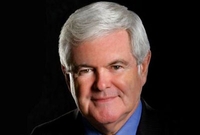Having completed their Civil War trilogy, ex–House Speaker Gingrich and historian Forstchen return their attention to World War II (they previously collaborated on 1945
). The attack on Pearl Harbor occupies the final quarter of the book, and the extensive leadup begins in 1930s Japan and provides readers not well versed in Japanese history a decent thumbnail sketch of Japanese culture and the events that preceded the attack. The authors' research shines in accurate accounts of diplomatic maneuvering as well as the nuts-and-bolts of military action, beginning with the Japanese invasion of China. Fans of the authors will expect their trademark "alternative" ending. In this case, the Japanese attack far more vigorously and devastate a larger chunk of the U.S. Pacific fleet than they actually did. How this affects the war's outcome will be revealed in the sequel. Gingrich and Forstchen, though adept at bigger-picture issues, falter when it comes to establishing and developing characters; FDR, Churchill and Hirohito come across as caricatures who move the plot along by mouthing historically appropriate lines, while the soldier-heroes exist to explain their nation's point-of-view to the reader. The recent success of Letters from Iwo Jima
may attract readers who would otherwise shy away from military history fiction. (May)


